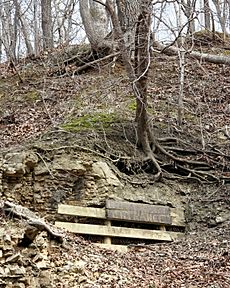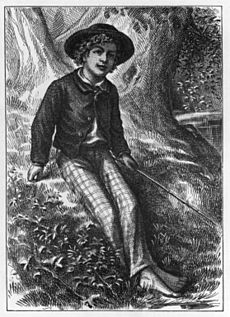Mark Twain Cave facts for kids
Quick facts for kids Mark Twain Cave |
|
|---|---|

The 1890 entrance to Mark Twain Cave
|
|
| Location | Hannibal, Missouri, U.S. |
| Show cave opened | 1886 |
| Designated: | 1972 |
The Mark Twain Cave, once known as McDowell's Cave, is a cool cave you can visit near Hannibal, Missouri. It's named after the famous writer Mark Twain, whose real name was Samuel Langhorne Clemens. Sam Clemens lived in Hannibal from age 4 to 17.
This cave is the oldest one in Missouri that offers tours, and it's been open since 1886! In 1972, both Mark Twain Cave and a nearby cave called Cameron Cave became National Natural Landmarks. This means they are special natural places. The cave is also famous because it's featured in Mark Twain's book, The Adventures of Tom Sawyer, where it's called "McDougal's Cave." It was renamed in honor of the author in 1880.
Contents
About the Cave
How the Cave Was Formed
Mark Twain Cave and its neighbor, Cameron Cave, are different from most of the 6,500+ caves in Missouri. Scientists believe they are parts of a much bigger cave system. This system was broken up by a glacier and millions of years of erosion. This makes people wonder if there are more hidden caves around Hannibal!
A big difference about Mark Twain Cave is that it doesn't have many speleotherms. These are mineral deposits like stalagmites and stalactites that you often see in large open cave rooms. Instead, Mark Twain Cave and Cameron Cave have lots of narrow, winding paths.
The caves are mostly made of a soft rock called Louisiana Lithographic Limestone. This special limestone is only found in a 35-mile area around Hannibal and Louisiana, Missouri. Geologists think this limestone is about 350 million years old. The cave passages themselves were formed around 100 million years ago. Mark Twain Cave has about 6.5 miles of passages with four entrances and 260 different paths. The temperature inside is always about 52 degrees Fahrenheit (11 degrees Celsius) all year round.
Discovery and Early Visitors
It's possible that Native Americans knew about the cave a long time ago. But the first recorded discovery was in the winter of 1819-1820. A local hunter named Jack Simms found it when his dog chased an animal into a small opening. When he and his brothers explored with torches, they found a huge underground maze!
The cave became a popular spot for people in Hannibal in the mid-1800s, especially for kids like young Sam Clemens. His adventures exploring the cave as a child later appeared in five of his books. Because the cave valley was cool, it was a favorite place for family picnics and church trips in the summer.
The Cave Becomes a Tourist Spot
Not many people outside of Hannibal knew about the cave until 1876. That's when Mark Twain's famous book, The Adventures of Tom Sawyer, was published. Soon, tourists from all over the world wanted to see the real cave that inspired "MacDougal's Cave" in the book. This was the cave where Tom and Becky Thatcher had a scary adventure.
The first regular tours for paying visitors started in 1886. A local farmer named John East charged people a dime to see the famous spots inside the cave. At first, they used the original opening, but it was too small for many visitors. So, in 1890, a new entrance was made nearby.
For over 50 years, tourists explored the cave just like Twain did, by candlelight or lantern. This changed in 1939 when electric lights were added to the tour areas. Judge E.T. Cameron, who had been a guide there when he was young, bought the cave in 1923. He was the first to set up clear tour routes, build a small building for tickets, and advertise the cave as "Mark Twain Cave."
Finding Cameron Cave
One cold winter day in 1925, Judge Cameron's son, Arch, was looking after their cattle. He noticed steam coming from a hole in the ground across the valley from Mark Twain Cave. After some digging, he found a large underground room. As he explored more, he discovered another cave, even bigger than Mark Twain Cave, with even more twisted paths! This "sister" cave was named Cameron Cave, after his family.
You can take tours of Cameron Cave too, but they are more like how tours used to be. There are no electric lights, and only changes needed for safety have been made.
The Cave Today
The entire cave area is owned by the Coleberd family, who are descendants of Judge Cameron. It includes Mark Twain and Cameron caves, a campground, a gift shop, a candle shop, and a winery.
You can also enjoy "The Life and Times of Mark Twain," a show where an actor tells stories and jokes about the author's life. A newer addition is Sticks & Stones, a fun gem shop. Here, kids and adults can "sluice" for semi-precious stones, much like Mark Twain did when he tried gold panning.
A famous visitor to Mark Twain Cave was U.S. President Jimmy Carter, who toured with his family in 1979. The guided tour of Mark Twain Cave takes about 55 minutes. The larger Cameron Cave tour is about one hour and twenty minutes long. Mark Twain Cave is open all year, except on Thanksgiving and Christmas. Cameron Cave is open from Memorial Day through Labor Day.
Finding Sam Clemens' Signature
For many years, people searched for Sam Clemens' signature inside the cave. Visitors had written over 250,000 signatures on the walls using candle smoke, pencil, paint, and even berry juice.
On July 26, 2019, Cindy Lovell found "Clemens" written on the cave wall. She used to be the director of the Mark Twain Boyhood Home & Museum and the Mark Twain House. She and the cave owner, Linda Coleberd, had been looking for the signature for decades. Mark Twain experts Alan Gribben and Kevin Mac Donnell confirmed that it was real.
Images for kids




